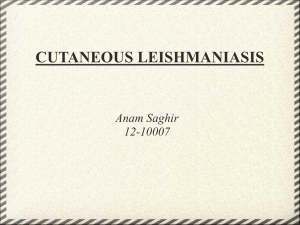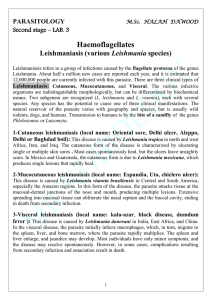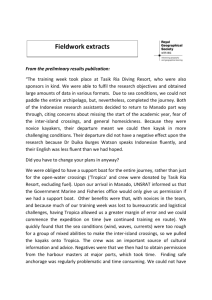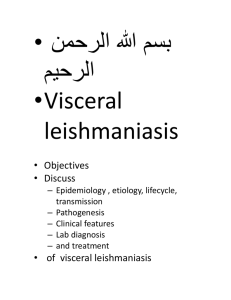Document 13310942
advertisement
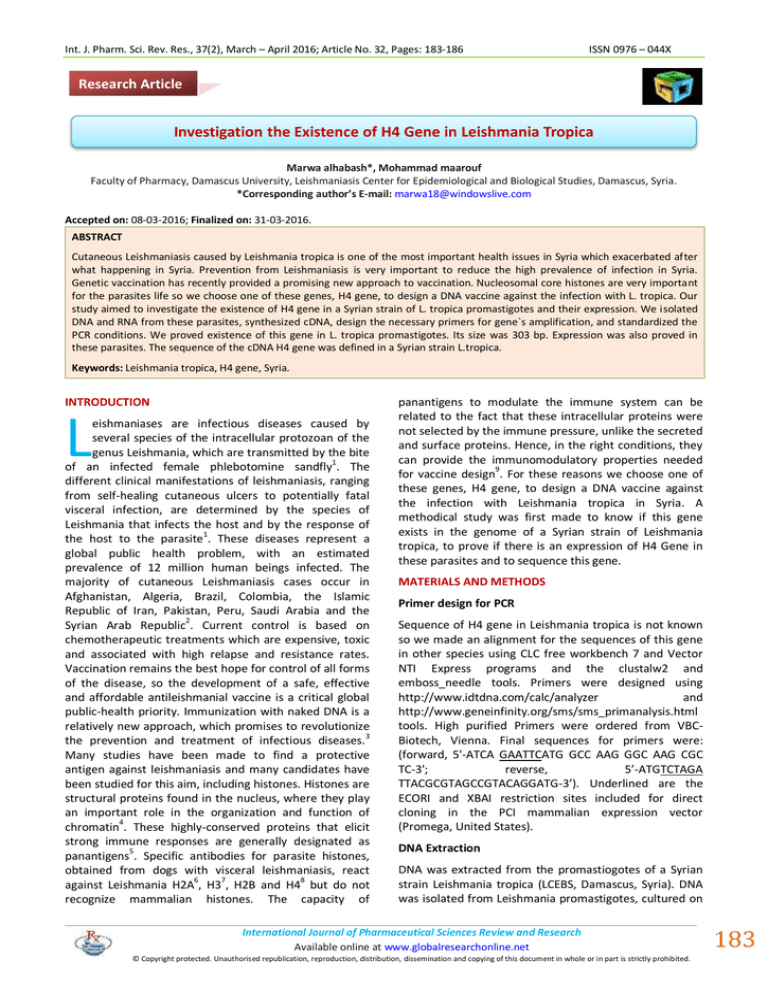
Int. J. Pharm. Sci. Rev. Res., 37(2), March – April 2016; Article No. 32, Pages: 183-186 ISSN 0976 – 044X Research Article Investigation the Existence of H4 Gene in Leishmania Tropica Marwa alhabash*, Mohammad maarouf Faculty of Pharmacy, Damascus University, Leishmaniasis Center for Epidemiological and Biological Studies, Damascus, Syria. *Corresponding author’s E-mail: marwa18@windowslive.com Accepted on: 08-03-2016; Finalized on: 31-03-2016. ABSTRACT Cutaneous Leishmaniasis caused by Leishmania tropica is one of the most important health issues in Syria which exacerbated after what happening in Syria. Prevention from Leishmaniasis is very important to reduce the high prevalence of infection in Syria. Genetic vaccination has recently provided a promising new approach to vaccination. Nucleosomal core histones are very important for the parasites life so we choose one of these genes, H4 gene, to design a DNA vaccine against the infection with L. tropica. Our study aimed to investigate the existence of H4 gene in a Syrian strain of L. tropica promastigotes and their expression. We isolated DNA and RNA from these parasites, synthesized cDNA, design the necessary primers for gene`s amplification, and standardized the PCR conditions. We proved existence of this gene in L. tropica promastigotes. Its size was 303 bp. Expression was also proved in these parasites. The sequence of the cDNA H4 gene was defined in a Syrian strain L.tropica. Keywords: Leishmania tropica, H4 gene, Syria. INTRODUCTION L eishmaniases are infectious diseases caused by several species of the intracellular protozoan of the genus Leishmania, which are transmitted by the bite of an infected female phlebotomine sandfly1. The different clinical manifestations of leishmaniasis, ranging from self-healing cutaneous ulcers to potentially fatal visceral infection, are determined by the species of Leishmania that infects the host and by the response of 1 the host to the parasite . These diseases represent a global public health problem, with an estimated prevalence of 12 million human beings infected. The majority of cutaneous Leishmaniasis cases occur in Afghanistan, Algeria, Brazil, Colombia, the Islamic Republic of Iran, Pakistan, Peru, Saudi Arabia and the Syrian Arab Republic2. Current control is based on chemotherapeutic treatments which are expensive, toxic and associated with high relapse and resistance rates. Vaccination remains the best hope for control of all forms of the disease, so the development of a safe, effective and affordable antileishmanial vaccine is a critical global public-health priority. Immunization with naked DNA is a relatively new approach, which promises to revolutionize 3 the prevention and treatment of infectious diseases. Many studies have been made to find a protective antigen against leishmaniasis and many candidates have been studied for this aim, including histones. Histones are structural proteins found in the nucleus, where they play an important role in the organization and function of 4 chromatin . These highly-conserved proteins that elicit strong immune responses are generally designated as 5 panantigens . Specific antibodies for parasite histones, obtained from dogs with visceral leishmaniasis, react 6 7 8 against Leishmania H2A , H3 , H2B and H4 but do not recognize mammalian histones. The capacity of panantigens to modulate the immune system can be related to the fact that these intracellular proteins were not selected by the immune pressure, unlike the secreted and surface proteins. Hence, in the right conditions, they can provide the immunomodulatory properties needed for vaccine design9. For these reasons we choose one of these genes, H4 gene, to design a DNA vaccine against the infection with Leishmania tropica in Syria. A methodical study was first made to know if this gene exists in the genome of a Syrian strain of Leishmania tropica, to prove if there is an expression of H4 Gene in these parasites and to sequence this gene. MATERIALS AND METHODS Primer design for PCR Sequence of H4 gene in Leishmania tropica is not known so we made an alignment for the sequences of this gene in other species using CLC free workbench 7 and Vector NTI Express programs and the clustalw2 and emboss_needle tools. Primers were designed using http://www.idtdna.com/calc/analyzer and http://www.geneinfinity.org/sms/sms_primanalysis.html tools. High purified Primers were ordered from VBCBiotech, Vienna. Final sequences for primers were: (forward, 5'-ATCA GAATTCATG GCC AAG GGC AAG CGC TC-3'; reverse, 5’-ATGTCTAGA TTACGCGTAGCCGTACAGGATG-3’). Underlined are the ECORI and XBAI restriction sites included for direct cloning in the PCI mammalian expression vector (Promega, United States). DNA Extraction DNA was extracted from the promastiogotes of a Syrian strain Leishmania tropica (LCEBS, Damascus, Syria). DNA was isolated from Leishmania promastigotes, cultured on International Journal of Pharmaceutical Sciences Review and Research Available online at www.globalresearchonline.net © Copyright protected. Unauthorised republication, reproduction, distribution, dissemination and copying of this document in whole or in part is strictly prohibited. 183 Int. J. Pharm. Sci. Rev. Res., 37(2), March – April 2016; Article No. 32, Pages: 183-186 RPMI-1640 medium (Lonza, Switzerland) supported with Fetal bovine serum (Cytogen, GmbH, Germany), with DNA extraction kit (Thermoscientific, Lithuania) according to manufacturer’s instructions. ISSN 0976 – 044X showed a standard profile and there was no contamination with genomic DNA (figure 2). The purity of the RNA was 2.1 which showed a sufficient degree of purity. RNA Isolation and cDNA Synthesis Total RNA was extracted from harvested Leishmania tropica promastigotes using TRI reagent (Sigma, St Louis, MO, USA). RNA was quantified by NanoDrop1000 (Thermo Fisher Scientific MA, USA). RNA-integrity was checked by separating in 1.5% agarose gel. First strand cDNAs were synthesized using RevertAid First Strand cDNA Synthesis kit (Thermoscientific, Lithuania) according to manufacturer’s instructions. Polymerase Chain Reaction DNA and cDNA of H4 gene were amplified by thermal cycler (Bio-Rad, USA) using PCR master mix (Thermoscientific, Lithuania) and the primers mentioned above. PCR protocol was optimized using gradient annealing temperatures. Reactions were performed in 25 μl of a mixture containing 1µl of 10µM from each primer, 2,5 µl of template DNA or cDNA (110 ng\µl), 12,5 µl of PCR master mix and 8 µl of PCR water. Thermal cycling conditions were 95°C for 5min followed by 35 cycles of 95°C for 1min, 62°C for 45sec and 72°C for 1 min finally 72°C for 5 min. PCR products were loaded on a 2% agarose gel, stained with ethidium bromide, and visualized on a UV transilluminator. Plasmid construction and purification PCR product containing H4 coding sequence was purified using Gene Jet PCR Purification kit (Thermoscientific, Lithuania) according to manufacturer’s instructions. Purified cDNA and the PCI mammalian expression vector (Promega, United States) were double digested with ECORI plus XBAI. Digested cDNA was ligated with the digested PCI mammalian expression vector using t4 DNA ligase (Thermoscientific, Lithuania). PCI-H4 clones were transformed in to Ecoli TOP 10. Recombinant plasmid was extracted from colonies and purified using GF-1 plasmid DNA extraction kit (Vivantis, Malaysia). Sequences Analysis Figure 1: Electrophoresis of extracted Leishmania tropica DNA: Lane 1 DNA ladder 1Kb, Lane 2,3 extracted Leishmania tropica DNA. Figure 2: Electrophoresis of extracted Leishmania tropica RNA: Lane1 Leishmania tropica RNA, Lane 2 extracted Leishmania tropica DNA. Polymerase Chain Reaction PCR protocol was optimized using gradient annealing temperatures and we chose the most suitable annealing temperature which was 62°C. We don't compare our result with other studies since they didn't mention their PCR conditions10,11 Gel electrophoresis of H4 PCR product on the level of DNA and RNA showed only one band of 303 base pair which proves the specificity of our primers. So we proved the existence of H4 gene in the genome of a Syrian strain of Leishmania tropica and in the RNA of this strain (figure 3). Full-length double-stranded sequence analysis was performed on purified Recombinant plasmid PCI-H4 by sequencing, using T7 (forward) and PCR 3' (reverse) vector primers on automated sequencers (ABI PRISM BigDye Terminator Cycle Sequencing Ready Reaction Kit, Perkin-Elmer, Foster City, USA). RESULTS AND DISCUSSION Evaluation DNA and RNA quality and purity Extracted DNA electrophoresis on a 1% agarose gel showed only one band which proves that there isn't any degradation in the extracted DNA (figure 1). The purity of the DNA was 1.8 which showed a high degree of purity. Extracted RNA electrophoresis on a 1.5% agarose gel Figure 3: Amplification products of Leishmania tropica H4 on 2% agarose gel electrophoresis stained with ethidium bromide. Lane 1 DNA ladder 50bp, lane 2, 3 H4-DNA International Journal of Pharmaceutical Sciences Review and Research Available online at www.globalresearchonline.net © Copyright protected. Unauthorised republication, reproduction, distribution, dissemination and copying of this document in whole or in part is strictly prohibited. 184 Int. J. Pharm. Sci. Rev. Res., 37(2), March – April 2016; Article No. 32, Pages: 183-186 amplification product of 303 bp, lane 4 H4-cDNA amplification product of 303 bp. Cloning and sequencing of the H4 cDNA In an effort to clone and characterize the Leishmania tropica H4 gene, a cDNA clone was identified and sequenced. The sequence was submitted to the Gene bank under KT956067 Accession number. Figure 3 shows the complete nucleotide sequence of the 303bp cDNA insert and the deduced amino acid sequence in comparison with other species. The deduced amino acid sequence predicts a protein containing 100 amino acids ISSN 0976 – 044X and having a predicted molecular mass of 11,439 Da. The H4 predicted amino acid sequence was compared with the sequences of proteins coded by cDNA of H4 in other species of Leishmania such as L.infantum, L.major, L.donovania, L.mexicana and L.braziliensis using Vector NTI Program. This search revealed that H4 belongs to the histone H4 family. Interestingly, L.tropica H4 shows significant similarity with H4 histones of L.infantum, L.major, L.donovania (96%), L.mexicana and L.braziliensis (91%). Figure 4: Nucleotide sequence of L. tropica H4 cDNA. The deduced amino acid sequence is indicated below the cDNA sequence. International Journal of Pharmaceutical Sciences Review and Research Available online at www.globalresearchonline.net © Copyright protected. Unauthorised republication, reproduction, distribution, dissemination and copying of this document in whole or in part is strictly prohibited. 185 Int. J. Pharm. Sci. Rev. Res., 37(2), March – April 2016; Article No. 32, Pages: 183-186 CONCLUSION 6. Soto M, Requena J, Quijada L, García M, Guzman F, Patarroyo M, Alonso C, Mapping of the linear antigenic determinants from the Leishmania infantum histone H2A recognized by sera from dogs with leishmaniasis, Immunology Letter, 48, 1995, 209–214. 7. Soto M, Requena J, Quijada L, Gomez C, Guzman F, Patarroyo M, Alonso C, Characterization of the antigenic determinants of the Leishmania infantum histone H3 recognized by antibodies elicited during canine visceral leishmaniasis, Clinical and experimental immunology, 106, 1996, 454–461. 8. Soto M, Requena J, Quijada L, Perez J, Nieto G, Guzman F, Patarroyo M, Alonso C, Antigenicity of the Leishmania infantum histones H2B and H4 during canine viscerocutaneous leishmaniasis, Clinical and experimental immunology, 115, 1999, 342–349. 9. Carrión J, Folgueira C, Alonso C, Development of Immunization Strategies against Leishmaniosis based on the Leishmania Histones Pathoantigens, Procedia in Vaccinology, 1, 2009, 101–103. Our results proved the existence of H4 gene in the genome of Syrian strain Leishmania tropica and in the RNA of this strain. We defined the sequence of the cDNA of Leishmania tropica H4 gene and submitted it to the Gene bank under KT956067 accession number. REFERENCES 1. Desjeux P, Leishmaniasis: current situation and new perspectives, Comparative Immunology, Microbiology and Infectious Disease, 27, 2004, 18–305. 2. WHO | Burden and distribution. <http://www.who.int/leishmaniasis/burden/en/> 3. Mutiso J, Development of Leishmania vaccines: predicting the future from past and present experience, Journal of Biomedical research, 27, 2013, 85–102. 4. Carneiro M, Santos D, Fukutani K, Clarencio J, Carlos Miranda J, Brodskyn C, Barral A, Barral-Netto M, SotoM, Vaccination with L. infantum chagasi Nucleosomal Histones Confers Protection against New World Cutaneous Leishmaniasis Caused by Leishmania braziliensis, PLoS One, 7, 2012. 5. at Requena J, Alonso C, Soto M, Evolutionarily Conserved Proteins as Prominent Immunogens during Leishmania Infections, Trends in parasitology, 16, 2000, 246-250. ISSN 0976 – 044X 10. Iborra S, Soto M, Carrión J, Alonso C, Requena J. M, Vaccination with a plasmid DNA cocktail encoding the nucleosomal histones of Leishmania confers protection against murine cutaneous leishmaniosis, Vaccine, 22, 2004, 3865–3876. 11. Carrión J, Folgueira C, Alonso C, Transitory or long-lasting immunity to Leishmania major infection: The result of immunogenicity and multicomponent properties of histone DNA vaccines, Vaccine, 26, 2008, 1155–1165. Source of Support: Nil, Conflict of Interest: None. International Journal of Pharmaceutical Sciences Review and Research Available online at www.globalresearchonline.net © Copyright protected. Unauthorised republication, reproduction, distribution, dissemination and copying of this document in whole or in part is strictly prohibited. 186
